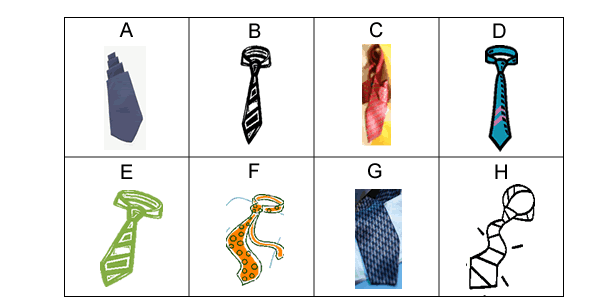Skip over navigation



Or search by topic
Number and algebra
Geometry and measure
Probability and statistics
Working mathematically
Advanced mathematics
For younger learners
It's a Tie
Age 7 to 11
Challenge Level 





Kaia's father always wore a white shirt and coloured tie for work.
He didn't like deciding which tie to wear so he would put his hand
in the drawer and wear the first tie that he pulled out. Each
evening the tie would go back in the drawer.
One Friday morning, Kaia said, "Do you like that tie? You usually wear it at least twice a week."
"I do not," replied her father, "I have eight ties and I only work five days a week. I certainly don't wear any tie more than once a week."
"You have worn that tie twice a week in at least five of the ten weeks you have been taking me to school," Kaia insisted.
"Impossible! Prove it!" challenged her father.
Do you think Kaia or her father was right? Why?
That weekend Kaia did an experiment. She made the following drawings of his ties and created the chart shown below.

How might Kaia use the drawings and chart to prove her father wrong?
Try doing an experiment yourself to find out which ties might be chosen.
What did the result of your experiment show?
One Friday morning, Kaia said, "Do you like that tie? You usually wear it at least twice a week."
"I do not," replied her father, "I have eight ties and I only work five days a week. I certainly don't wear any tie more than once a week."
"You have worn that tie twice a week in at least five of the ten weeks you have been taking me to school," Kaia insisted.
"Impossible! Prove it!" challenged her father.
Do you think Kaia or her father was right? Why?
That weekend Kaia did an experiment. She made the following drawings of his ties and created the chart shown below.

| Week no. | Monday | Tuesday | Wednesday | Thursday | Friday |
| 1 | |||||
| 2 | |||||
| 3 | |||||
| 4 | |||||
| 5 | |||||
| 6 | |||||
| 7 | |||||
| 8 | |||||
| 9 | |||||
| 10 | |||||
| 11 | |||||
| 12 | |||||
| 13 | |||||
| 14 | |||||
| 15 | |||||
| 16 | |||||
| 17 | |||||
| 18 | |||||
| 19 | |||||
| 20 |
How might Kaia use the drawings and chart to prove her father wrong?
Try doing an experiment yourself to find out which ties might be chosen.
What did the result of your experiment show?
You may also like
Roll These Dice
Roll two red dice and a green dice. Add the two numbers on the red dice and take away the number on the green. What are all the different possible answers?
Stop or Dare
All you need for this game is a pack of cards. While you play the game, think about strategies that will increase your chances of winning.
Game of PIG - Sixes
Can you beat Piggy in this simple dice game? Can you figure out Piggy's strategy, and is there a better one?

